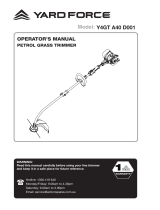
11
English(Original instructions)
Your product has been engineered and manufactured to
Ryobi’s high standard for dependability, ease of operation,
and operator safety. Properly cared for, it will give you
years of rugged, trouble-free performance.
WARNING
To avoid serious personal injury, do not attempt to use
this product until you read thoroughly and understand
completely the operator’s manual. Failure to comply
may result in accidents involving electric shock, fi re,
and/or serious personal injury. Save this operator’s
manual and review frequently for continuing safe
operation and instructing others who may use this
product.
READ ALL INSTRUCTIONS
GENERAL SAFETY RULES
■ Do not allow children or untrained individuals to use
this product.
■ Never start or run the engine inside a closed or poorly
ventilated area; breathing exhaust fumes can kill.
■ Clear the work area before each use. Remove all
objects, such as rocks, broken glass, nails, wire
that can lead to accidents. Remove all objects such
as cords, lights, wire, or string which can become
entangled in the cutting blade.
■ Always use eye protection which is marked to comply
with EN 166.
■ Wear head and eye protection to prevent injury from
falling debris.
■ Wear heavy, long trousers, boots and gloves. Do not
wear loose fitting clothing, shorts, jewelry of any kind,
or go barefoot.
■ Secure long hair so it is above shoulder level to
prevent entanglement in any moving parts.
■ Keep all bystanders, children, and pets at least 15 m
away.
■ Do not operate this unit when you are tired, ill, or under
the influence of alcohol, drugs, or medication.
■ Do not operate in poor lighting.
■ Keep firm footing and balance. Do not overreach.
Overreaching can result in loss of balance or exposure
to hot surfaces.
■ Keep all parts of your body away from any moving
part.
■ Do not touch area around the exhaust, silencer or
engine of the unit; these parts get hot during operation.
■ Always stop the engine, remove the spark plug
wire and allow the product to cool before refuelling,
cleaning, maintenance or storage.
■ Inspect the unit before each use for loose fasteners,
fuel leaks, etc.
■ Replace any damaged parts before use.
■ Check for and tighten any loose parts.
■ Mix and store fuel in a container approved for fuel.
■ Mix fuel outdoors where there are no sparks or flames.
Wipe up any fuel spillage. Move 9 m away from
refuelling site before starting engine.
■ Stop the engine and allow to cool before refuelling or
storing the unit.
■ Debris when hit by the blade can become thrown
objects and may travel significant distances.
■ Remove all debris from the work area before operating.
■ Keep bystanders (especially children) away from the
working area by 15 m.
■ Allow the engine to cool; empty the fuel tank and
secure the unit from moving before transporting in
a vehicle. Cover the blade with the blade protector
before storing the unit, or during transportation.
SPECIFIC SAFETY RULES
STRING TRIMMER
■ Replace string head if cracked, chipped, or damaged
in any way. Make sure the trimmer head is properly
installed and securely fastened. Failure to do so can
cause serious injury.
■ Make sure all guards, deflectors and handles are
properly and securely attached.
■ Use only original manufacturer’s replacement parts.
■ Never operate the product without the safety guard in
place and in good condition.
■ Use a firm grip on the handles. Make sure you hold
the tool firmly with both handles and that you are well
balanced with your weight evenly distributed on both
feet.
■ Keep the trimmer head below waist level. Never use
the product with the cutting head positioned 76 cm or
more above ground level.
BRUSHCUTTER
■ After engine stops, keep rotating blade in heavy grass
or pulpy weeds until it stops.
■ Never operate the product without the safety guard in
place and in good condition.
■ Use heavy gloves while installing or removing blades.
■ Always stop the engine and remove the spark plug
wire before attempting to remove any obstruction
caught or jammed in the blade or before removing and














